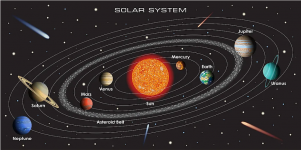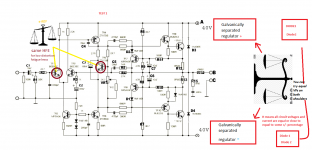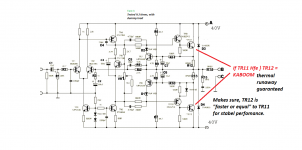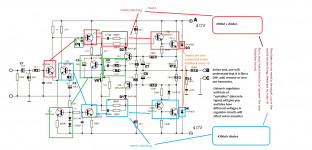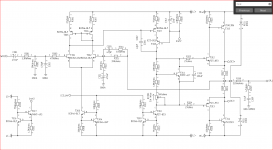Guys, what do you think where the bandwidth is getting its first form? with-in or outside the box ? 😀
And we also know that proper grounding has a huge effect on overall performance of an amplifier, how should it be done than?
Everyone is doing it differently and there is no end to this disaster 😀
And we also know that proper grounding has a huge effect on overall performance of an amplifier, how should it be done than?
Everyone is doing it differently and there is no end to this disaster 😀
I think that we can even compare this topology with the solar system somehow😀
I mean, Hifi is about some action in the speakers that we usually don't perceive with normal gear right ? And Hifi likes to be different at some points of the time, otherwise it would be very dissapointing and listener might find himself a little lonely.... Hifi must move, like a planet orbiting around its axis or around some other object.
Then there is that consciousness and unconsciousness.....
One good example is an "artefact"... this is used a lot in games and movies.
You also can perceive artefacts in acoustics... they are precious lol i know😀 I think julian discovered it first. but whatever.
We can then connect artefact with consciousness and unconsciousness, who know's what producer is doing there with the music creation... maybe even the creator of the program doesnt notice it 😀😀
I mean, Hifi is about some action in the speakers that we usually don't perceive with normal gear right ? And Hifi likes to be different at some points of the time, otherwise it would be very dissapointing and listener might find himself a little lonely.... Hifi must move, like a planet orbiting around its axis or around some other object.
Then there is that consciousness and unconsciousness.....
One good example is an "artefact"... this is used a lot in games and movies.
You also can perceive artefacts in acoustics... they are precious lol i know😀 I think julian discovered it first. but whatever.
We can then connect artefact with consciousness and unconsciousness, who know's what producer is doing there with the music creation... maybe even the creator of the program doesnt notice it 😀😀
Attachments
None of those lead-free solders are the best for hand soldering, which is the 4% Ag, 0.5% Cu, 95.5% Sn composition which is a euctectic (the important requirement for hand-soldering is that the solder freezes at a single temperature, so that it doesn't go pasty and make a dry-joint in the presence of movement - which happens in hand-soldering).I have 5 different solders:
Pb free 97/3cu Germany
Pb free 99/1cu Germany
Pb free 99/1Ag Germany
Pb free 99.9% la canada
63Sn/37Pb some china solder
Euctectics are much easier to work with anyway, especially for rework.
Good point, also with every component change new solder joints must be clean and look as new 😛
There is that flux content also but i am not going that deep, gray area for me.
Its like this:

Everyone happy if good combination between layout, component choice and environment is found😀
There is that flux content also but i am not going that deep, gray area for me.
Its like this:

Everyone happy if good combination between layout, component choice and environment is found😀
What if i say its not about the lowest distortion.... its the tuning(distortion that harmonizes with the output signal)... i just dont have the words to explain it omg...🙁
I try... would it be correct to say that we can actually benefit from some "kind" of a distortion and it will help to change the output sound to something exiting..
Look at people for example and how everyones voice is so different, some seem so funny, while other seem cool(distorded) and effective in some ways,
then there are female voices that sound so soft/unique... one can fall a sleep while listening to her/she.
To make an amplifier "exiting" and not too linear = booring, we have to inject something in there... And it can be done with-in the amplifier circuit. And its the best in-circuit... cuz mixing in pre-amps for simple HiFi is false tbh.
Forexample, Sony RX55 does something in the circuit, ~20 years have been passed and i never even bother to open this little HiFI all in one box... it still produces that sound + some harmonics that makes music littlebit more interesting and it stands clearly out with its sound from many amps. And i think it will stand for more then 20+ years or indefinitely😀
I have had some "standalone" japanese, JVC amps. They are powerful indeed... and thats all..... but you have to have good mood to listen to these so called "natural sound" amplifiers. EDIT: I mean they are not bad sounding or anythings, its just they dont fit in for "excitement" or "entertainment"
EDIT: Look no further 😀 Playstation 1 vs Sega console of the same era, did you guys notice the difference in graphics... Sega was "clean" undistorted", Sony PS1 was "crispy-Bright" like a good cookie 😀 And thats why most of us loved PS1 🙂
Chips like:
TDA2050:
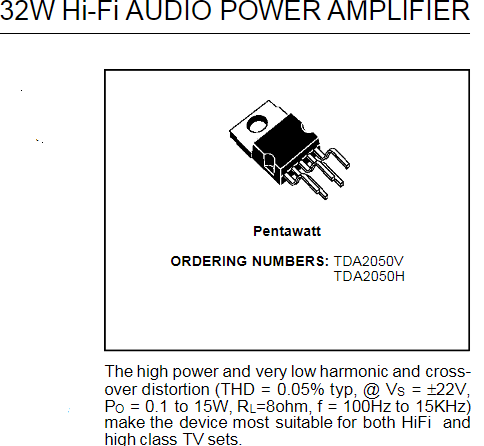
LM1875:

These solid-states also sound kinda nice, not too boring and again theyr distortion is pretty high compared to what we want to archive in here😛
Imo if you want clean undistorted sound, better to buy studio amp off the shelf, they cost nothing imo 😛
I suggest to not waste time on this circuit until some serious minds make an agreement to how to, what goes were and so on😉
This green smile ---> 😀 reminds me someone:

I try... would it be correct to say that we can actually benefit from some "kind" of a distortion and it will help to change the output sound to something exiting..
Look at people for example and how everyones voice is so different, some seem so funny, while other seem cool(distorded) and effective in some ways,
then there are female voices that sound so soft/unique... one can fall a sleep while listening to her/she.
To make an amplifier "exiting" and not too linear = booring, we have to inject something in there... And it can be done with-in the amplifier circuit. And its the best in-circuit... cuz mixing in pre-amps for simple HiFi is false tbh.
Forexample, Sony RX55 does something in the circuit, ~20 years have been passed and i never even bother to open this little HiFI all in one box... it still produces that sound + some harmonics that makes music littlebit more interesting and it stands clearly out with its sound from many amps. And i think it will stand for more then 20+ years or indefinitely😀
I have had some "standalone" japanese, JVC amps. They are powerful indeed... and thats all..... but you have to have good mood to listen to these so called "natural sound" amplifiers. EDIT: I mean they are not bad sounding or anythings, its just they dont fit in for "excitement" or "entertainment"
EDIT: Look no further 😀 Playstation 1 vs Sega console of the same era, did you guys notice the difference in graphics... Sega was "clean" undistorted", Sony PS1 was "crispy-Bright" like a good cookie 😀 And thats why most of us loved PS1 🙂
Chips like:
TDA2050:

LM1875:

These solid-states also sound kinda nice, not too boring and again theyr distortion is pretty high compared to what we want to archive in here😛
Imo if you want clean undistorted sound, better to buy studio amp off the shelf, they cost nothing imo 😛
I suggest to not waste time on this circuit until some serious minds make an agreement to how to, what goes were and so on😉
This green smile ---> 😀 reminds me someone:

Last edited:
A black cat crossing a country road looks mysterious to me so perhaps that's how you like your audio impressions to be interpreted - from visual suggestion and impression rather than the matter-of-fact seriousness of physics?
Many audiophiles, intimidated by the math, probably feel the same way about their musical experiences in audio as you express. They try to align the physics involved with their emotional experience of the music program and particular audio system. This certainly adds something mysterious to their expression, usually in the form of visual and emotive imagery rather than technical detail.
For an enlightening explanation of audiophile quality sound reproduction, Jean Hiraga carried out extensive investigative work and published it in "Revue Du Son" around 2003 when he was editor of the magazine. You could check out all his personal articles on preferred harmonic distortion profiles for his amplifier projects like "le monstre" (8W class A) and this 30W monster, for another example: Jean Hiraga Super Class A 30w Build. There are threads here for those DIY designs and a number of cheap parts kits are still available too, if you search.
The following interview/discussion article was authored by member Jan Didden (then editor of AudioXpress magazine) and sums up the concepts and key differences to normal, hi-fi defined audio systems. It's a good and very interesting read and introduction to audiophile concepts if your French and English skills are OK. Musicality and Distortion: A Conversation | audioXpress
I should add that this is serious audio stuff - not just added sound effects for fun. People pay big bucks for high-end audiophile quality gear but only peanuts for straightforward, very low distortion hifi gear. There has to be a good reason there, somewhere😀
Many audiophiles, intimidated by the math, probably feel the same way about their musical experiences in audio as you express. They try to align the physics involved with their emotional experience of the music program and particular audio system. This certainly adds something mysterious to their expression, usually in the form of visual and emotive imagery rather than technical detail.
For an enlightening explanation of audiophile quality sound reproduction, Jean Hiraga carried out extensive investigative work and published it in "Revue Du Son" around 2003 when he was editor of the magazine. You could check out all his personal articles on preferred harmonic distortion profiles for his amplifier projects like "le monstre" (8W class A) and this 30W monster, for another example: Jean Hiraga Super Class A 30w Build. There are threads here for those DIY designs and a number of cheap parts kits are still available too, if you search.
The following interview/discussion article was authored by member Jan Didden (then editor of AudioXpress magazine) and sums up the concepts and key differences to normal, hi-fi defined audio systems. It's a good and very interesting read and introduction to audiophile concepts if your French and English skills are OK. Musicality and Distortion: A Conversation | audioXpress
I should add that this is serious audio stuff - not just added sound effects for fun. People pay big bucks for high-end audiophile quality gear but only peanuts for straightforward, very low distortion hifi gear. There has to be a good reason there, somewhere😀
Last edited:
but only peanuts for straightforward, very low distortion hifi gear. There has to be a good reason there, somewhere
Yep, thats what i am all about.
I am a believer, in science and technology.
Naim is also a believer, just look some videos of theyrs.
Black cat goes well with HiFi imo😀
I think i have done my job, everything else is up to u guys.
I'm reading this nad140 thread. I went to the end and I want to ask a question.
All those talking about the sound are with using preamp. or not?
Preamplificator changes the all sound colour. Do I have to use preamplificator for DAC for example. Now I added a simple preamp. and I don't decide with pre or not?
All those talking about the sound are with using preamp. or not?
Preamplificator changes the all sound colour. Do I have to use preamplificator for DAC for example. Now I added a simple preamp. and I don't decide with pre or not?
The NAP topology is actually fairly compromised... but it was heavily optimised to sound really good with the NAC preamps.
Will it also sound really good with other preamps? It might, but it's less likely....
Will it also sound really good with other preamps? It might, but it's less likely....
I have tried a lot of transistor preamps, op amp, lamps, buffers, direct cd player output, the best results have always been with the NAC and the Crimson.
I had some good with an AGI and a Rappaport, but always came back to basics
I had some good with an AGI and a Rappaport, but always came back to basics
Yesterday, I tried PREAMP 7 P7 MINI, uses NJM4580 very simple preamp for LJM's amp.s. Sound more clear (perhaps sharp) I think. Testing... But, I will buy a NAC kit.
I think the Physics behind this concept is this :

Left is "-" middle is "GND" and right is "+"
Now, if we want 99,9% pureness on the output, we stick to the scales righttttt, but to make it "hifi", we get them to move there and there, like dancin😀
DC offsets are useful yep to move the soundstage around the room. Staying within +|- 50mV = alot of opportunities.
But, the first image is the most important, or all of them.

Left is "-" middle is "GND" and right is "+"
Now, if we want 99,9% pureness on the output, we stick to the scales righttttt, but to make it "hifi", we get them to move there and there, like dancin😀
DC offsets are useful yep to move the soundstage around the room. Staying within +|- 50mV = alot of opportunities.
But, the first image is the most important, or all of them.
Attachments
Rensli, I think you may be the only one crazy enough to think far enough "out of the box". Keep it up. 🙂What if i say its not about the lowest distortion...
How so?The NAP topology is actually fairly compromised... but it was heavily optimised to sound really good with the NAC preamps.
Will it also sound really good with other preamps? It might, but it's less likely....
+1Rensli, I think you may be the only one crazy enough to think far enough "out of the box". Keep it up. 🙂
It's interesting to see how far we are moving from the original NAP250 amp-only design that people refer to here because it's all they can find on the net. Is it relevant to NAP140 as well, given that owners usually find those early models to be significantly different sounding?
As more recent models go, the attached Nait 5i power section schematic has been circulating for some years now and though the integrated design makes it comparable to the original Nait series, the power level of 80WPC/4R puts it right up with the original NAP160 model. I've never owned one but I've listened and liked what I heard though it didn't have quite the sizzle or PR&T of earlier models like the NAP140 with NAC42 preamp, for example. What do you all now think about advanced Naits like this one? Maybe the next Naim clone should be more this kind of integrated too?
As more recent models go, the attached Nait 5i power section schematic has been circulating for some years now and though the integrated design makes it comparable to the original Nait series, the power level of 80WPC/4R puts it right up with the original NAP160 model. I've never owned one but I've listened and liked what I heard though it didn't have quite the sizzle or PR&T of earlier models like the NAP140 with NAC42 preamp, for example. What do you all now think about advanced Naits like this one? Maybe the next Naim clone should be more this kind of integrated too?
Attachments
Yesterday, I tried PREAMP 7 P7 MINI, uses NJM4580 very simple preamp for LJM's amp.s. Sound more clear (perhaps sharp) I think. Testing... But, I will buy a NAC kit.
Today I build NAC42 preamp kit. It's ok, worked. But, when listening there was a random pulse (like a connection problem) I think. I assumed it's due to ground problem (NAC42 has no ground, only +&- psu input). I test it later. So, I couldn't say it's good or not 🙁
NAC 42 or perhaps you mean the NAC42.5 clone PCB kit designed by LJM? In either case, there definitely is a common connection for signal ground to input and output. Otherwise the audio would be...er...inaudible! However, LJM's clone kit version of NAC42.5, just has simple 3-way cable connections via terminal blocks for input and output plus a 2-way block for the unbalanced, +24V power supply. The power supply is a simple +24VDC and common ground which should be isolated from any other ground to avoid ground loops. Only a little 20-24VAC plugpack transformer is needed but the lead to the preamp should also be twisted to reduced hum radiation, not that it should be much.
I use an LM7824 IC regulator following a standard app. note design but the kit version has an integral DC PSU based on LM317T, which may be quieter. PSUs need careful design and assembly for best low-noise results and that's why the "overkill" of Naim's Hicap and Flatcap series external PSUs and upgrades which were introduced in later years.
You can see some example detail pics of the clone kit here but there are plenty of others: [DIY KIT] Single-Ended Preamplifier Kit Clone NAC-42.5 Pre-amp Kit 2019 New | eBay
Original Naim preamps are powered and coupled with multi-pin DIN connectors and NAC42 had a 4 pin DIN, NAC42.5 had 5 pin, to suit the special, external "Hi Cap" and "Flat-Cap" series power supplies and later model power amps.
I use an LM7824 IC regulator following a standard app. note design but the kit version has an integral DC PSU based on LM317T, which may be quieter. PSUs need careful design and assembly for best low-noise results and that's why the "overkill" of Naim's Hicap and Flatcap series external PSUs and upgrades which were introduced in later years.
You can see some example detail pics of the clone kit here but there are plenty of others: [DIY KIT] Single-Ended Preamplifier Kit Clone NAC-42.5 Pre-amp Kit 2019 New | eBay
Original Naim preamps are powered and coupled with multi-pin DIN connectors and NAC42 had a 4 pin DIN, NAC42.5 had 5 pin, to suit the special, external "Hi Cap" and "Flat-Cap" series power supplies and later model power amps.
- Home
- Amplifiers
- Solid State
- NAP-140 Clone Amp Kit on eBay
